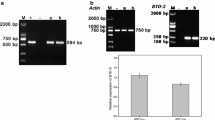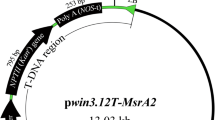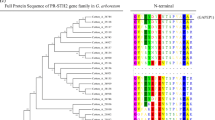Abstract
Key message
Novel function and mechanism of a PNP molecule VaEG45 from adzuki bean involved in plant immunity.
Abstract
Plant natriuretic peptides (PNPs) can affect a broad spectrum of physiological responses in plants acting as peptidic signaling molecules. However, PNPs may play additional roles in plant immunity. Our previous transcriptome data of adzuki bean (Vigna angularis) in response to Uromyces vignae infection revealed association of PNP-encoding gene VaEG45 with U. vignae resistance. To determine the function of VaEG45 in disease resistance, we cloned the 589 bp nucleotide sequence of VaEG45 containing 2 introns, encoding a putative 13.68 kDa protein that is 131 amino acids in length. We analyzed expression in different resistant cultivars of V. angularis and found significant induction of VaEG45 expression after U. vignae infection. Transient expression of VaEG45 improved tobacco resistance against Botrytis cinerea. We next analyzed the mechanism by which VaEG45 protects plants from fungal infection by determination of the biological activity of the prokaryotic expressed VaEG45. The results showed that the fusion protein VaEG45 can significantly inhibit urediospores germination of U. vignae, mycelial growth, and the infection of tobacco by B. cinerea. Further analysis revealed that VaEG45 exhibits β-1, 3-glucanase activity. These findings uncover the function of a novel PNP molecule VaEG45 and provide new evidence about the mechanism of PNPs in plant immunity.






Similar content being viewed by others
Data availability
The data that support the findings of this study are available from the corresponding author upon reasonable request.
References
Ceccardi TL, Barthe GA, Derrick KS (1998) A novel protein associated with citrus blight has sequence similarities to expansin. Plant Mol Biol 38:775–783. https://doi.org/10.1023/a:1006039016393
Chi C, Shen YQ, Yin LH, Ke XW, Han D, Zuo YH (2016) Selection and validation of reference genes for gene expression analysis in Vigna angularis using quantitative real-time RT-PCR. PLoS ONE 11:e0168479. https://doi.org/10.1371/journal.pone.0168479
Dai LM, Wang D, Xie XQ, Zhang CH, Wang XP, Xu Y, Wang YJ, Zhang JX (2016) The novel gene VpPR4-1 from Vitis pseudoreticulata increases powdery mildew resistance in transgenic Vitis vinifera L. Front Plant Sci 7:695. https://doi.org/10.3389/fpls.2016.00695
Davies GJ, Tolley SP, Henrissat B, Hjort C, Schulein M (1995) Structures of oligosaccharide-bound forms of the endoglucanase V from Humicola insolens at 1.9 A resolution. Biochemistry 34:16210–16220. https://doi.org/10.1021/bi00049a037
Doi K, Kaga A, Tomooka N, Vaughan DA (2002) Molecular phylogeny of genus Vigna subgenus Ceratotropis based on rDNA ITS and atpB-rbcL intergenic spacer of cpDNA sequences. Genetica 114:129–145. https://doi.org/10.1023/a:1015158408227
Ficarra FA, Grandellis C, Garavaglia BS, Gottig N, Ottado J (2018) Bacterial and plant natriuretic peptides improve plant defense responses against pathogens. Mol Plant Pathol 19:801–811. https://doi.org/10.1111/mpp.12560
Gehring C, Irving H (2013) Plant natriuretic peptides: systemic regulators of plant homeostasis and defense that can affect cardiomyoblasts. J Investig Med 61:823–826. https://doi.org/10.2310/JIM.0b013e3182923395
Han D (2017) Screening cultivars of resistant to rust and the resistant mechanism to rust of adzuki bean. Dissertation, Heilongjiang Bayi Agricultural University
Jiang L, Wu J, Fan S, Li W, Dong L, Cheng Q, Xu P, Zhang S (2015) Isolation and characterization of a novel pathogenesis-related protein gene (GmPRP) with induced expression in soybean (Glycine max) during infection with Phytophthora sojae. PLoS ONE 10:e0129932. https://doi.org/10.1371/journal.pone.0129932
Ke XW, Wang J, Xu XD, Guo YX, Zuo YH, Yin LH (2022) Histological and molecular responses of Vigna angularis to Uromyces vignae infection. BMC Plant Biol 22:489. https://doi.org/10.1186/s12870-022-03869-2
Kramer C, Soltani N, Robinson DE, Swanton CJ, Sikkema PH (2012) Control of volunteer adzuki bean in soybean. Agric Sci 3:501–509. https://doi.org/10.4236/as.2012.34059
Lee KP, Liu K, Kim EY, Medina-Puche L, Dong H, Duan J, Li M, Dogra V, Li Y, Lv R, Li Z, Lozano-Duran R, Kim C (2020) PLANT NATRIURETIC PEPTIDE A and its putative receptor PNP-R2 antagonize salicylic acid-mediated signaling and cell death. Plant Cell 32:2237–2250. https://doi.org/10.1105/tpc.20.00018
Li S, Wang Z, Tang BF, Zheng LL, Chen HJ, Cui XM, Ge F, Liu DQ (2020) A pathogenesis related protein like gene is involved in the Panax notoginseng defense response to the root rot pathogen. Front Plant Sci 11:610176. https://doi.org/10.3389/fpls.2020.610176
Liu L, Bestel S, Shi J, Song Y, Chen X (2013) Paleolithic human exploitation of plant foods during the last glacial maximum in North China. Proc Natl Acad Sci USA 110:5380–5385. https://doi.org/10.1073/pnas.1217864110
Liu X, Guan HR, Wang TS, Meng D, Wei YF, Dai JK, Fan N, Guo B, Fu YP, He W, Wei YH (2020) ScPNP-A, a plant natriuretic peptide from Stellera chamaejasme, confers multiple stress tolerances in Arabidopsis. Plant Physiol Biochem 149:132–143. https://doi.org/10.1016/j.plaphy.2020.02.005
Livak KJ, Schmittgen TD (2001) Analysis of relative gene expression data using real-time quantitative PCR and the 2(−Delta Delta C(T)) method. Methods 25:402–408. https://doi.org/10.1006/meth.2001.1262
Ludidi NN, Heazlewood JL, Seoighe C, Irving HR, Gehring CA (2002) Expansin-like molecules: novel functions derived from common domains. J Mol Evol 54:587–594. https://doi.org/10.1007/s00239-001-0055-4
Ludidi N, Morse M, Sayed M, Wherrett T, Shabala S, Gehring C (2004) A recombinant plant natriuretic peptide causes rapid and spatially differentiated K+, Na+ and H+ flux changes in Arabidopsis thaliana roots. Plant Cell Physiol 45:1093–1098. https://doi.org/10.1093/pcp/pch113
Maryani MM, Shabala SN, Gehring CA (2000) Plant natriuretic peptide immunoreactants modulate plasma-membrane H+ gradients in Solanum tuberosum L. leaf tissue vesicles. Arch Biochem Biophys 376:456–458. https://doi.org/10.1006/abbi.2000.1736
Maryani MM, Bradley G, Cahill DM, Gehring CA (2001) Natriuretic peptides and immunoreactants modify osmoticum-dependent volume changes in Solanum tuberosum L. mesophyll cell protoplasts. Plant Sci 161:443–452. https://doi.org/10.1016/S0168-9452(01)00423-X
Meier S, Bastian R, Donaldson L, Murray S, Bajic V, Gehring C (2008) Co-expression and promoter content analyses assign a role in biotic and abiotic stress responses to plant natriuretic peptides. BMC Plant Biol 8:1–12. https://doi.org/10.1186/1471-2229-8-24
Morse M, Pironcheva G, Gehring C (2004) AtPNP-A is a systemically mobile natriuretic peptide immunoanalogue with a role in Arabidopsis thaliana cell volume regulation. FEBS Lett 556:99–103. https://doi.org/10.1016/s0014-5793(03)01384-x
Nie JJ, Zhou WJ, Liu JY, Tan N, Zhou JM, Huang LL (2021) A receptor-like protein from Nicotiana benthamiana mediates VmE02 PAMP-triggered immunity. New Phytol 229:2260–2272. https://doi.org/10.1111/nph.16995
Pharmawati M, Gehring CA, Irving HR (1998) An immunoaffinity purified plant natriuretic peptide analogue modulates cGMP levels in the Zea mays root stele. Plant Sci 137:107–115. https://doi.org/10.1016/S0168-9452(98)00135-6
Pharmawati M, Maryani MM, Nikolakopoulos T, Gehring CA, Irving HR (2001) Cyclic GMP modulates stomatal opening induced by natriuretic peptides and immunoreactive analogues. Plant Physiol Biochem 39:385–394. https://doi.org/10.1016/S0981-9428(01)01252-9
Schülein M, Kauppinen MS, Lange L, Lassen SF, Nielsen JB (1998) Characterization of fungal cellulases for fiber modification. In: Enzyme applications in fiber processing, vol 687, pp 66–74. https://doi.org/10.1021/BK-1998-0687.CH006
Shi Y, Zhang Y, Shih DS (2006) Cloning and expression analysis of two β-1,3-glucanase genes from Strawberry. J Plant Physiol 163:956–967. https://doi.org/10.1016/j.jplph.2005.09.007
Stavely JR (1985) The modified Cobb scale for estimating bean rust intensity. Annu Rep Bean Improv Coop 28:31–32
Tunyasuvunakool K, Adler J, Wu Z, Green T, Zielinski M, Žídek A et al (2021) Highly accurate protein structure prediction for the human proteome. Nature 596:590–596. https://doi.org/10.1038/s41586-021-03828-1
Turek I, Marondedze C, Wheeler JI, Gehring C, Irving HR (2014) Plant natriuretic peptides induce proteins diagnostic for an adaptive response to stress. Front Plant Sci 5:1–11. https://doi.org/10.3389/fpls.2014.00661
Turek I, Wheeler J, Bartels S, Szczurek J, Wang YH, Taylor P, Gehring C, Irving H (2020) A natriuretic peptide from Arabidopsis thaliana (AtPNP-A) can modulate catalase 2 activity. Sci Rep 10:19632. https://doi.org/10.1038/s41598-020-76676-0
Turek I, Gehring C, Irving H (2021) Arabidopsis plant natriuretic peptide is a novel interactor of rubisco activase. Life 11:21. https://doi.org/10.3390/life11010021
Van Loon LC, Rep M, Pieterse CM (2006) Significance of inducible defense-related proteins in infected plants. Annu Rev Phytopathol 44:135–162. https://doi.org/10.1146/annurev.phyto.44.070505.143425
Vesely DL, Giordano AT (1991) Atrial natriuretic peptide hormonal system in plants. Biochem Biophys Res Commun 179:695–700. https://doi.org/10.1016/0006-291x(91)91428-f
Vesely DL, Gower WR, Giordano AT (1993) Atrial natriuretic peptides are present throughout the plant kingdom and enhance solute flow in plants. Am J Physiol 265:e465–e477. https://doi.org/10.1152/ajpendo.1993.265.3.E465
Wang YH, Gehring C, Cahill DM, Irving HR (2007) Plant natriuretic peptide active site determination and effects on cGMP and cell volume regulation. Funct Plant Biol 34:645–653. https://doi.org/10.1071/FP06316
Zheng SJ, Ke XW, Yin LH, Cui DM, Zhang HT, Tai LM, Zuo YH (2015) Identification of a fungal isolate causing adzuki bean rust in Heilongjiang. Acta Microbiol Sin 55:425–432. https://doi.org/10.13343/j.cnki.wsxb.20140457
Zimmermann P, Hirsch-Hoffmann M, Hennig L, Gruissem W (2004) GENEVESTIGATOR. Arabidopsis microarray database and analysis toolbox. Plant Physiol 136:2621–2632. https://doi.org/10.1104/pp.104.046367
Zribi I, Ghorbel M, Brini F (2021) Pathogenesis related proteins (PRs): from cellular mechanisms to plant defense. Curr Protein Pept Sci 22:396–412. https://doi.org/10.2174/1389203721999201231212736
Acknowledgements
The research was supported by the Heilongjiang Provincial Natural Science Foundation of China (YQ2020C034) and the National Natural Science Foundation of China (32102173).
Funding
This work was funded by the Heilongjiang Provincial Natural Science Foundation of China (YQ2020C034) and the National Natural Science Foundation of China (32102173).
Author information
Authors and Affiliations
Contributions
YZ: conceptualization, methodology, manuscript review. XK: funding acquisition, manuscript review, validation, and editing. WS: original draft, investigation, methodology, resources. MY: methodology, resources. LY: methodology, review and editing, funding acquisition. All authors read and approved the manuscript.
Corresponding authors
Ethics declarations
Conflict of interest
The authors have declared that no conflict of interest exists.
Additional information
Communicated by Leandro Peña.
Publisher's Note
Springer Nature remains neutral with regard to jurisdictional claims in published maps and institutional affiliations.
Supplementary Information
Below is the link to the electronic supplementary material.
Rights and permissions
Springer Nature or its licensor (e.g. a society or other partner) holds exclusive rights to this article under a publishing agreement with the author(s) or other rightsholder(s); author self-archiving of the accepted manuscript version of this article is solely governed by the terms of such publishing agreement and applicable law.
About this article
Cite this article
Sun, W., Yuan, M., Yin, L. et al. A natriuretic peptide molecule from Vigna angularis, VaEG45, confers rust resistance by inhibiting fungal development. Plant Cell Rep 42, 409–420 (2023). https://doi.org/10.1007/s00299-022-02967-7
Received:
Accepted:
Published:
Issue Date:
DOI: https://doi.org/10.1007/s00299-022-02967-7




